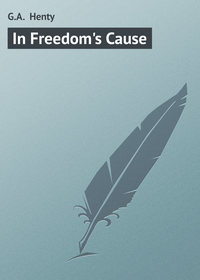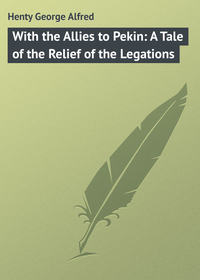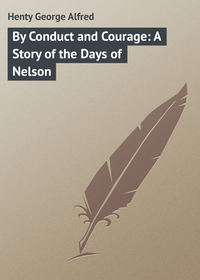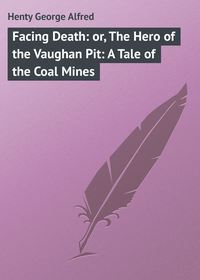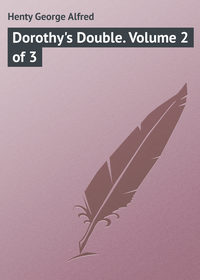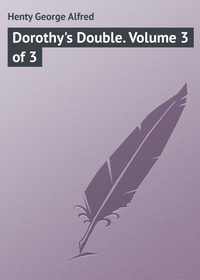 полная версия
полная версияThe Young Colonists: A Story of the Zulu and Boer Wars
“The native contingent was called in, and the naval brigade and two guns, under Lieutenant Lloyd, and two companies of the Buffs were ordered to take up a position upon a knoll close to the road, on which they were halted. The sailors at once opened fire on the enemy with two 7-pounders and two 24-pounder rocket-tubes, while the Buffs poured a heavy fire with their rifles upon them. The waggons were still coming up, and these were parked as they reached the ground; and two companies of the Buffs, who were guarding them on the march, being now free to act, were ordered to move out in skirmishing order, and draw the enemy out of the bush, when, as they retired, they were exposed to the fire from the knoll.
“The engineers and mounted troops moved forward, with the infantry skirmishers, supported by a half-company of the Buffs and a half-company of the 99th. The enemy tried to outflank their left, and Captain Campbell with a portion of the naval brigade and some of the native contingent went out and drove them from a kraal of which they had taken possession. A still farther advance was now made, and the Zulus took to flight, leaving 300 dead upon the ground. The attacking party were 5000 strong, and against these some 500 or 600 of our troops were engaged. We had only eight Europeans killed and four natives, and about twenty wounded. The next day Colonel Pearson reached Ekowe. The position was a strong one, as the place stood upon rising ground; it had been a missionary station, and there was a church which could at the worst be converted into a citadel.
“Colonel Pearson at once set to work to fortify the position. The same evening the news arrived of the disaster at Isandula. After a consultation with his officers Colonel Pearson decided to hold the spot at which he now was, convinced that, without further supplies of reinforcements, he could hold the place for two months. In order to economise food, the mounted men and most of the natives were sent back, and there remained 1200 British troops.
“Colonel Pearson at once commenced his preparations for a siege. Three moderate-sized brick erections were turned into store-houses, and the church into a hospital, the tower making a capital look-out; from this a splendid view was obtained, the hill by the Tugela being clearly visible. The men set to work to fortify the place. The intrenchments were of a six-sided form, about sixty yards across, with a ditch outside them eighteen feet deep and twelve feet wide. Assegais were planted in the bottom. Added to the south side was a kraal for cattle and horses, also defended by a small wall. Outside the fort were entanglements of rows of felled trees and bushes. The supply of water was obtained from a good well, outside the walls, but covered by the fire of the fort. The guns were placed in position, and the garrison was ready for any attack that might be made upon them. All these details we learned in the early days of the siege by occasional messengers, who managed to find their way through, but these had been few and far between; of twelve messengers sent out the first week of February, only one got through. The garrison had made several sorties, and had destroyed Dabulamanzi’s kraal. They also went out and cut off a large convoy of cattle on its way to Ulundi.”
“But how have they found out what is being done at Ekowe, if the first week only one messenger got through out of twelve?” Dick said.
“By a very ingenious plan, Dick. For three weeks we knew nothing of what was going on, and then it struck an engineer that communication might be established by flashing signals.”
“What are flashing signals, father?”
“Well, my boy, as a general rule they are made by showing a light either for a long or short period. Thus, one long and one short might be A; one short and one long, B; two short and one long, C; and so on all through the Alphabet. The distance was so great that ordinary lights would not have answered, but it struck one of the engineers that with a looking-glass the sunlight might be reflected. You know at what a distance the sun’s reflection on a window can be made out. Well, it was tried in vain for a whole week by Lieutenant Haynes, of the Royal Engineers, but at the end of that time he was delighted at seeing answering flashes from the hill on which Ekowe stands. Since that time news has been regularly received every day by this means of what is passing in the fort.
“In the meantime preparations were being made for the relief of the garrison. The news of the defeat at Isandula was sent home by a swift ship, by which the particulars were telegraphed from Saint Vincent. The people at home did not lose an hour. The Shah, which was on her way home, heard the news at Saint Helena, and Captain Bradshaw, who commanded her, at once, on his own responsibility, turned his ship’s head south, and steered for Durban, bringing with him the garrison of the island. Some draughts from the 4th, 88th, and 99th Regiments were brought down from the Cape; the Boadicea also arrived, and every man who could be spared from her and the Shah was landed and sent up to the Tugela.
“In the second week in March the 57th and 91st Regiments arrived from England. One hundred and sixty men were brought over from the garrison of Mauritius, and a few days later the 3rd battalion of the 60th Regiment also arrived. These assembled on the Tugela on the 27th, and that day set out. The vanguard was composed of the seamen and marines of the Shah and Tenedos– 640 men and two gatlings, the 91st regiment of 900 men, 400 men of the 99th, 180 men of the 3rd Buffs, 150 mounted infantry, 200 of the mounted native contingent, and 1600 men of the native infantry contingent. The second division consisted of 200 men of the Boadicea with gatlings, the 37th Regiment, and the 3rd battalion of the 60th, 900 men, and two troops of mounted natives. That is all I can tell you, my boy. The news only arrived here yesterday that they had started. In the course of three or four more days I hope that we shall hear that they have given the Zulus a thorough licking. It is a strong force, and as there are about 3300 white troops among them, and there is no fear of their being taken by surprise this time, we need not have any anxiety about the result. I understand that, in accordance with the advice which Colonel Pearson has flashed from Ekowe, they are not going to follow the road he took, but to keep along on the lower ground near the sea.”
“And do you think, father, that they will push on for Ulundi when they have rescued the garrison of Ekowe?”
“No, Dick; I think they are quite strong enough to do so, but as there are at least half a dozen more regiments on their way out from England, including some regiments of cavalry, it will be more prudent to stop until our whole fighting force is here, when we ought to be enabled to make short work of them, and to do the work completely and effectually. And now, Dick, I am thoroughly sleepy – the sooner we are in bed the better.”
Chapter Eight.
The Second Advance
It was some days before the news reached Newcastle of the complete success of the relieving column. On their first day’s march no difficulty was met with. The road was a good one, and the Zulus did not show in any force. The column halted for the night near the junction of the Inyoni and Amatikulu rivers. The waggons were placed in laager and a ditch and parapet formed round the camp. The ground was open and the waggons were able to travel six abreast. Numerous Zulu kraals were passed; but these were found deserted.
On the afternoon of the 1st they encamped at Ginghilovo. From this point Ekowe was visible; signals were exchanged with the besieged, and Colonel Pearson warned Lord Chelmsford that the Zulus were moving forward to attack him. The night passed quietly, but the greatest vigilance was maintained.
At daybreak dense masses of Zulus were seen in the distance, and at six o’clock they approached the camp. They came on in their usual order, with a massive centre and advanced horns on either flank. The British were kept lying down behind the shallow trenches they had thrown up. The Zulus advanced in splendid order with a sort of dancing step. Their white and coloured shields, their crests of leopard skins and feathers, and the long ox-tails dangling from their necks gave them a wild and strange appearance. Every ten or fifteen yards the first line would halt, a shot would be fired, then a loud yell burst forth, and they again advanced with a humming sound, in time to which their dancing movement was kept up. The 60th, who lay opposite to the point against which they advanced, withheld their fire until the first line of skirmishers came to within 300 yards. Then a deadly sheet of flame flashed along the ridge of the shelter-trench, and a number of the Zulu warriors fell.
The main body now rushed forward, and although a tremendous fusilade was kept up on them, the Zulu advance pressed on, ever fed by those in the rear, which deployed in excellent order as they reinforced the first line. For twenty minutes the fire of the 60th never ceased. Again and again the Zulus pressed forward, but their leading ranks were swept away by the storm of bullets.
At half-past six the Zulu masses, without the smallest confusion, faced to their right, ran round in columns, and fell upon the face of the laager held by the 57th and 91st. Here they were as hotly received as they had been by the 60th. Notwithstanding the deadly fire, the Zulus pressed forward with noble courage. They had ceased to shout now, and seemed only anxious to reach the square. Four times they rushed forward; each time they fell back with terrible loss. The fire of the soldiers was assisted by that of the native contingent, who, posted in the waggons behind, added their fire to that of the 91st and 57th.
The last attack was led by Dabulamanzi in person, and arrived within five yards of the muzzles of the men’s rifles; indeed one or two of the chiefs actually seized the hot barrels with one hand, while they stabbed at the men with their shortened assegais.
This was their final repulse, and they now began to fall back. The moment that they did so, the cavalry dashed out in pursuit, and chased them far across the plain. The gatlings and 9-pounders added in no slight degree to the effect of the rifles. The entire English loss was but two officers and four privates killed, and three officers and thirty-four privates wounded; while the Zulu loss exceeded 1000. The force under Dabulamanzi was about 11,000, and a similar force was close at hand, but fortunately had not joined that of Dabulamanzi before he attacked the British.
On the following day the 57th, 60th, and 91st, together with the mounted men and several of the mounted brigade, taking with them three days’ provisions, marched for Ekowe. Major Barrow scouted the ground, and reported that everywhere assegais, shields, feathers, ear and head ornaments, skins, furs, blankets, and ever; guns were lying about in confusion, evidently cast away in their headlong flight by the Zulus, but that none of these had been seen.
The column, however, advanced with every precaution, as it was possible that Dabulamanzi might procure reinforcements. No enemy, however, was met with, and the column continued its march until they were met by Colonel Pearson with 500 men, coming out to lend a hand to them in case they should be attacked. The united column then marched into Ekowe. The health of the garrison had suffered much from exposure to the sun and rain, and from the want of vegetables and useful medicine. Beef they had plenty of, as it was considered advisable to kill and consume the waggon-oxen rather than see them die from want of forage.
The great event of the siege had been the discovery of certain strange flashes of light on the white walls of the church-tower; these, after puzzling many of the officers and soldiers, were at length brought under the notice of an officer of the naval brigade, who had been trained in the use of the heliograph, and he was able at once to explain the mystery. They were three days before they could contrive an apparatus, which could be worked, to reply. Fortunately an old mirror was found, and communication was opened. The effect of their renewed intercourse with the outer world, and of learning the preparations which were being made for their relief, acted more beneficially on the health of the imprisoned garrison than all the tonics the hospital could afford. Nevertheless between the commencement of the siege and the arrival of the relief thirty deaths had occurred.
To the great regret of the garrison they found that it had been determined by the general to abandon the fort which they had held so long, as the whole force was required in Natal for operations in the veld in conjunction with the reinforcements on their way out. Before leaving, however, it was determined to strike another blow at Dabulamanzi, whose private residence had escaped at the time that his kraal was burnt. A small party of about 200 men therefore went out and fired the place without resistance. Ekowe was evacuated, and, having left a garrison at Ginghilovo, Lord Chelmsford retired with his force across the Tugela.
Every day for the next fortnight news reached Newcastle of the arrival of one or more transports with reinforcements, and in a month from the date of the arrival of the first from England, seventeen transports came in, bringing more than 9000 soldiers and 2000 horses. The force consisted of two regiments of cavalry, 1250 sabres, two batteries of artillery with 540 men, 190 men of the Royal Engineers, six regiments of infantry, 5320 bayonets, draughts of the regiments already in the colony and Army Service Corps’ men, 1200. Most of the regiments brought their equipments complete and ready for the field – tents, waterproof-sheets, cooking utensils, and camp stores. The Army Service Corps brought with them 100 light but strongly-built waggons.
Among the arrivals was the Prince Imperial of France, who had come out as a volunteer.
To convey the baggage and stores of so numerous a force an immense number of waggons was required, and a very urgent appeal was made to the loyalty of the colonists to furnish transport for the troops engaged in fighting their battles.
In answer to this appeal Mr Humphreys and Mr Jackson decided to send down the new waggons which had just been finished. Immediately they heard of the decision, Dick and Tom begged for permission again to accompany the waggons. Their mothers at first refused even to listen to the request, but their fathers, talking the matter over between them, agreed that harm was not likely this time to come of it.
The force was so overwhelmingly strong that there was not the slightest prospect of a repetition of the disaster of Isandula. At that time several hundred English soldiers had been surprised and crushed by some 20,000 of the enemy, but in future every precaution would be taken, and the British force would be ten times as strong as that which fought at Isandula. The colonists thought that it would be really an advantage to the boys to take part in the expedition; it was quite possible that if they remained in the colony they might have occasion to take part in wars with one or other of the native tribes, and the experience that they would gain in the campaign would in that case assuredly be useful to them. Having thus decided, Mr Humphreys and his friend succeeded in obtaining their wives’ consent to the boys accompanying the waggons, and in high glee they started for Durban on the 20th of April.
The campaign was arranged on a new plan. The numerous columns in which the strength of the force had been frittered away were abolished, and the following was adopted as the designation of the forces in the field, under the lieutenant-general commanding, viz.: – 1st Division South African Field-forces, Major-General Crealock, C.B., commanding, consisting of all troops on the left bank of the Lower Tugela; 2nd Division South African Field-forces, Major-General Newdigate commanding, consisting of all troops in the Utrecht district other than those attached to the Flying Column under Brigadier-General Wood, V.C., C.B., which was designated as “Brigadier-General Wood’s Flying Column.” Major-General Marshall assumed command of the cavalry brigade, and Major-General the Hon. H.H. Clifford, C.B., V.C., took up the command of the base of operations and superintendence of the lines of communication. The forces were divided as follows: —
First Division (General Crealock’s),
Lower Tugela Command.
Naval Brigade… 800
M. Battery, 6th Brigade, Royal Artillery… 90
Detachment, 11-7th Royal Artillery… 25
2-3rd Regiment… 836
57th Regiment… 830
3-60th Regiment… 880
88th Regiment… 640
91st Regiment… 850
99th… 870
Mounted Infantry, 2nd Squadron… 70
Army Service Corps… 50
Army Hospital Corps… 20
Royal Engineers… 150
8-7th Royal Artillery… 80
0-6th Regiment… 50
Lonsdale’s Horse… 84
Cooke’s Horse… 78
Colonial Volunteers… 105
Native Contingent: —
Foot… 2556
Mounted… 151
Total strength, effective and non-effective… 9215
Second Division (General Newdigate’s.)
1st Dragoon Guards attached to 2nd Division… 650
17th Lancers attached to 2nd Division… 626
N-5th Royal Artillery… 76
N-6th Royal Artillery… 80
10-7th Royal Artillery… 70
10-6th Royal Artillery… 30
Royal Engineers… 60
2-4th Regiment… 790
Detachment, 1-13th Regiment… 63
2-21st (two companies at Maritzburg)… 820
1-24th Regiment… 530
2-24th Regiment… 586
58th (one company at Durban)… 906
80th (several companies in the Transvaal)… 300
94th (one company at Grey Town)… 870
Army Service Corps… 60
Army Hospital Corps… 30
Grey Town District Colonial Volunteers… 139
Natal Mounted Police… 75
Natal Carabineers… 27
Newcastle Mounted Rifles… 18
Buffalo Mounted Guard… 20
Native Contingent: —
Europeans… 41
Natives (foot)… 3128
Natives (mounted)… 243
Total strength, effective and non-effective… 10,238
General Wood’s Flying Column.
11-7th Royal Artillery… 87
Royal Engineers… 13
1-13th Regiment… 721
90th Regiment… 823
1st Squadron, Mounted Infantry… 103
Army Service Corps… 9
Army Hospital Corps… 13
Frontier Light Horse… 173
Baker’s Horse… 179
Transvaal Rangers… 141
1st Battalion, Wood’s Irregulars: —
Europeans… 14
Natives… 377
2nd Battalion, Wood’s Irregulars: —
Europeans… 5
Natives… 355
Natal Native Horse: —
Europeans… 4
Natives… 75
Total strength, effective and non-effective… 3092
Grand Total.
1st Division… 9215
2nd Regiment… 10,238
General Wood’s Flying Column. 3092
Total, effective and non-effective: namely, Europeans, 15,660, and natives, 6885… 22,545
Out of this grand total there were about 400 sick and non-effective with the 1st Division, 300 with the 2nd Division, and 600 (including some of Wood’s Irregulars, absent and not accounted for since the 28th of March) with Wood’s Flying Column. So that altogether, deducting, say, 1500, Lord Chelmsford had at his disposal, from the middle of April, a total of 21,000 troops, of which over 15,000 were European. Colonels Pearson and Wood were made Brigadier-Generals, and the former was to command Number 1 Brigade, 1st Division, and Colonel Pemberton, 3-60th, the other. They both, however, had to give up their commands through sickness, and Colonels Rowland, V.C., C.B., and Clark, 57th Regiment, succeeded them.
Major-General Clifford, V.C., C.B., had the following staff for the management of the base of the operations and the maintenance of the lines of communication between Zululand and Natal: —
Lieutenant Westmacott, 77th Foot, aide-de-camp; Major W.J. Butler, C.B., assistant-adjutant and quartermaster-general, stationed at Durban; and Captain W.R. Fox, Royal Artillery, deputy assistant-adjutant and quartermaster-general.
On the arrival of the boys with the waggons at Pieter-Maritzburg, they reported themselves at the headquarters of the transport corps, and were told that they were not to go down to Durban, but were to load up at once and accompany the Dragoon Guards, who were to march the next morning for the front.
This time the lads were mounted, as their fathers thought that they would gain more benefit from their experience if they were able to move about instead of being confined to the sides of their waggons, and it was a satisfaction to their mothers that, in case of any untoward event again happening, they would be in a better position for making their escape.
General Newdigate’s columns were encamped at Landmann’s Drift; the cavalry, under General Marshall, was also there. The march was altogether without incident.
Some days passed quietly, when a small party of horse made an expedition to Isandula; they reported that nearly a hundred waggons were still standing upon the field of battle. On the 17th of May, three days later, the rumour ran through the camp that the cavalry were to start on the 19th, to bury the dead and bring away the waggons. The Army Service Corps and waggons were to accompany the party, which was to consist of the Dragoon Guards and Lancers, with a party of native mounted scouts.
In the afternoon of the 18th the two boys went to Colonel Marshall’s tent; they waited patiently until he came out, accompanied by two or three other officers.
“We have come to ask, sir, if you will allow us to go with your column. We are in charge of waggons here, but they are not going. We were at the battle, and saw the whole thing, and were taken prisoners afterwards and carried to Umbelleni’s kraal, where we were liberated when Colonel Wood’s cavalry attacked the Zlobani hill. We are well mounted, sir, and are good shots; so, if you will let us go, we could keep with the scouts and not be in your way.”
“How did you see the fight?” General Marshall asked.
“We had gone up to the top of the hill, sir, before it began, and fortunately the natives did not notice us.”
“Oh, yes, you can go,” the general said. “Probably you can give us a better account of the action than any one else, as others who escaped were occupied by their own business, and could not mark the general progress of the battle. So you were taken prisoners! Well, I am going out now, but if you will call in this evening at about half-past eight, I shall be glad to have a talk with you.”
In the evening the boys called upon the general, one of the most popular and dashing officers in the service. Three or four of his staff were there, and all listened with great interest to the boys’ account of their adventures.
“You seem to have plenty of pluck and coolness, youngsters,” the general said, when they had finished. “In future you need not trouble to ask for permission to accompany me whenever the cavalry go out, providing we have natives mounted with us; you must go as recruits, and can either keep with them or ride with my orderlies.”
Much pleased with the permission given, the lads returned to the waggons, and the next morning they started on their way.
The column bivouacked that night at Dill’s Town, and reached Rorke’s Drift between three and four o’clock in the morning, and were there joined by the Natal Carabineers and Colonel Harness, R.A., with guns.
At daybreak on the 20th the reconnoitring force crossed the river. No signs of the enemy were seen until they neared Isandula; then signal-fires blazed up on the hills to the right, and spread quickly from hill to hill far into the interior. Pushing steadily on, the plain of Isandula was reached by ten o’clock. The whole scene of the conflict was overgrown with long grass, thickly intermixed with growing crops of oats and Indian corn. Lying thickly here, and scattered over a wide area, lay the corpses of the soldiers. The site of the camp itself was marked by the remains of the tents, intermingled with a mass of broken trunks, boxes, meat-tins, papers, books, and letters in wild disorder. The sole visible objects, however, rising above the grass, were the waggons, all more or less broken up.
The scouts were placed in all directions to give warning of the approach of any enemies. The Army Service Corps set to work to harness the seventy pairs of led horses they had brought with them to the best of the waggons, and the troops wandered over the scene of the engagement, and searched for and buried all the bodies they found, with the exception of those of the 24th Regiment, as these, Colonel Glyn had asked, should be left to be buried by their comrades. The bodies of the officers of Colonel Durnford’s corps were all found together, showing that when all hope of escape was gone they had formed in a group and defended themselves to the last. The men of the Royal Artillery buried all the bodies of their slain comrades who could be found, but the shortness of the time and the extent of the ground over which the fight had extended rendered anything like a thorough search impossible.




